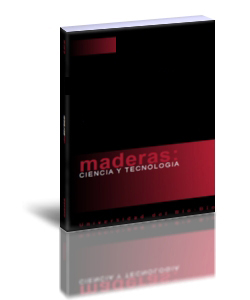Gluing characteristics of Papua New Guinea timber species for various non-structural applications
DOI:
https://doi.org/10.22320/s0718221x/2024.10Keywords:
Bondability, Papua New Guinea, plantations, shear strength, wood failure, glue bond strength, timberAbstract
Papua New Guinea (PNG) has abundant natural forest resources but there are many constraints which need to be addressed to support the development of competitive value-added wood industries. There is a need to develop knowledge and capacity in wood science and processing technologies which support successful domestic value-adding wood processing enterprises. A comprehensive testing program has been developed to assess the glue‐bond strength and performance of selected commercial PNG timber species in various cli- matic conditions to simulate service conditions in potential market destinations. Two criteria namely shear strength and wood failure have been used to determine if a species can meet the minimum requirements for either dry use or wet use applications. The performance of 24 different PNG commercial timber species has been assessed using a one-component cross-linking polyvinyl acetate emulsion adhesive. The bondability of the selected species has been carefully estimated considering the wood density and wood moisture content for the strength and durability in dry- and wet-use conditions. The testing results show that as the wood density as a wood property factor and moisture content as a service condition factor increase, high shear strength with high wood failure become more difficult to achieve consistently. The highest shear strength and wood failure results were achieved by softwood plantation species and low-density hardwood species. Based on the testing results, the selected species have been classified into bondability classes (bond very well, bond well, bond with difficulty, very difficult to bond).
Downloads
References
AS/NZS. 2010. Timber - Bond performance of structural adhesives. AS/NZS 4364. Standards Australia/ Standards New Zealand (AS/NZS): Sydney, NSW, AUS. https://infostore.saiglobal.com/en-us/standards/as- nzs-4364-2010-116357_saig_as_as_268372/
ASTM.1999. Standard practice for estimating the percentage of wood failure in adhesive bond- ed joints. ASTM D5266. American Society for Testing and Materials: West Conshohocken, PA, USA. https://www.astm.org/d5266-13r20.html
ASTM. 2010. Standard Practice for Sampling Forest Trees for Determination of Clear Wood Properties. ASTM D5536. American Society for Testing and Materials: West Conshohocken, PA, USA. https://www.astm. org/d5536-94r10.html
ASTM. 2008. Standard test method for strength properties of adhesive bonds in shear by compres- sion loading. ASTM D905. American Society for Testing and Materials: West Conshohocken, PA, USA. https://www.astm.org/d0905-08r21.html
ASTM. 2012. Standard terminology of adhesives. ASTM D907. American Society for Testing and Materials: West Conshohocken, PA, USA. https://www.astm.org/d0907-15.html
ASTM. 2012b. Standard specification for adhesives used for laminate joints in non-structural lum- ber products. ASTM D5751. American Society for Testing and Materials: West Conshohocken, PA, USA. https://www.astm.org/d5751-99r19.html
Aydin, I. 2004. Activation of wood surfaces for glue bonds by mechanical pre-treatment and its effects on some properties of veneer surfaces and plywood panels. Applied Surface Science 233(1-4):268-274. https://doi.org/10.1016/j.apsusc.2004.03.230
Belleville, B.; Iru, R.; Tsiritsi, C.; Ozarska, B. 2020a. Planing characteristics of Papua New Guinea timber species from plantations and regrowth forests. European Journal of Wood and Wood Products 78(2): 343-349. https://doi.org/10.1007/s00107-020-01495-z
Belleville, B.; Lancelot, K.; Galore, E.; Ozarska, B. 2020b. Assessment of physical and me- chanical properties of Papua New Guinea timber species. Maderas. Ciencia y Tecnología 22(1): 3-12. http://dx.doi.org/10.4067/S0718-221X2020005000101
Chen, C.M. 1970. Effect of extractive removal on adhesion and wettability of some tropical woods. Forest Products Journal 20(1): 36-41. https://www.cabdirect.org/cabdirect/abstract/19700607243
Frihart, C.R.; Hunt, C.G. 2010. Adhesives with wood materials - Bond formation and performance. Chapter 10. In: Wood handbook - Wood as an engineering material. USDA Forest service. Forest products laboratory: Madison, WI, USA. https://www.fpl.fs.usda.gov/documnts/fplgtr/fpl_gtr190.pdf
Frihart, C.R.; Beecher, J.F. 2016. Factors that Lead to Failure with Wood Adhesive Bonds. In World Conference on Timber Engineering, WCTE 2016, 22-25 August 2016. Vienna, Austria. 8 pp. https://www.fs.usda.gov/treesearch/pubs/53607
ISO. 2018. Adhesives - Wood-to-wood adhesive bonds – Determination of shear strength by compressive loading. ISO 6238. International Organisation for Standardization (ISO): Geneva, SWI. https://www.iso.org/ standard/72967.html
JOWAT. 2018a. Application Information - Solid Wood. Technical datasheet. Jowat Klebstoffe: Detmold, Germany. 4 p.
JOWAT. 2018b. Jowacoll® 107.20. Technical datasheet. Jowat Klebstoffe: Detmold, Germany. 3 p.
Kuljich, S.; Cool, J.; Hernández, R. 2013. Evaluation of two surfacing methods on black spruce wood in relation to gluing performance. Journal of Wood Science 59:185-194. https://doi.org/10.1007/s10086-012- 1318-y
Landry, V.; Blanchet, P. 2012. Surface preparation of wood for application of waterborne coatings. For- est Products Journal 62(1): 39-45. https://meridian.allenpress.com/fpj/article/62/1/39/136793/Surface-Prepa- ration-of-Wood-for-Application-of
Li, S.; Belleville, B.; Gutowski, M.; Kuys, B.; Ozarska, B. 2018. Achieving Long-Term Adhesion and Bondline Durability with difficult-to bond Australian Hardwoods Species. In Proceedings of 61st International Convention of Society of Wood Science and Technology, Nov 5-9, Nagoya, Japan. http://dx.doi.org/10.13140/ RG.2.2.29358.56648
Marra, A. 1992. Technology of wood bonding: principles in practice. Van Nostrand Reinhold: NY, USA. https://catalogue.nla.gov.au/catalog/2230681
Nussbaum, R.M.; Sterley, M. 2002. The effect of wood extractive content on glue adhesion and sur- face wettability of wood. Wood and Fiber Science 34(1): 57-71. https://wfs.swst.org/index.php/wfs/article/ view/612
Özçifçi, A.; Yapici, F. 2008. Effects of machining method and grain orientation on the bonding strength of some wood species. Journal of Materials Processing Technology 202: 353-358. https://www.sciencedirect. com/science/article/pii/S0924013607008850
Qin, Z.; Chen, H.; Gao, Q.; Zjhang, W.; Li, J. 2015. Wettability of sanded and aged fast-growing pop- lar wood surfaces: 1. Surface free energy. BioResources 10(1):1008-1023. https://bioresources.cnr.ncsu.edu/wp-content/uploads2016/06BioRes_10_1_1008_Qin_GZL_Wettability_Sanded_Aged_Poplar_I_4189.pdf
Roffael, E. 2016. Significance of wood extractives for wood bonding. Applied Microbiology and Biotech- nology 100: 1589-1596. https://doi.org/10.1007/s00253-015-7207-8
Roffael, E.; Dix, B. 1994. Unpublished work
Taylor, A.M.; Gartner, B.L.; Morrell, J.J. 2002. Heartwood Formation and natural durability - a review. Wood and Fiber Science 34(4): 587-611. https://wfs.swst.org/index.php/wfs/article/view/539
Vick, C.B. 1999. Chapter 9. Adhesive bonding of wood materials. In: Wood handbook: wood as an en- gineering material. USDA Forest Service, Forest Products Laboratory: Madison, WI, USA. https://www.fpl. fs.usda.gov/documnts/fplgtr/fplgtr113/ch09.pdf
Downloads
Published
How to Cite
Issue
Section
License

This work is licensed under a Creative Commons Attribution 4.0 International License.
Los autores/as conservarán sus derechos de autor y garantizarán a la revista el derecho de primera publicación de su obra, el cuál estará simultáneamente sujeto a la Licencia de Reconocimiento de Creative Commons CC-BY que permite a terceros compartir la obra siempre que se indique su autor y su primera publicación esta revista.




































